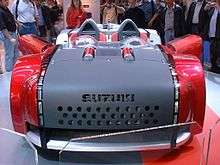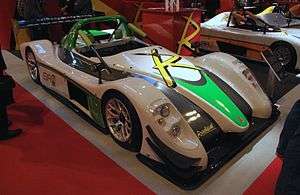Suzuki Hayabusa
The Suzuki Hayabusa (or GSX1300R) is a sport bike motorcycle made by Suzuki since 1999. It immediately won acclaim as the world's fastest production motorcycle, with a top speed of 303 to 312 km/h (188 to 194 mph).
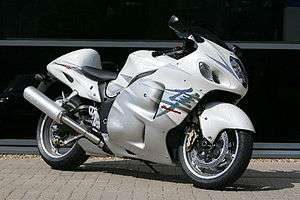 | |
| Manufacturer | Suzuki |
|---|---|
| Also called | GSX1300R, 'Busa[1] |
| Assembly | Toyokawa Plant, Toyokawa, Aichi, Japan Suzuki Gurgaon Plant, Gurgaon, India[2] |
| Class | sportbike |
| Top speed | 1999 303–312 km/h (188–194 mph)[3][4] 2000–present 299 km/h (186 mph)[5][6] |
| Related | Suzuki B-King |
In 1999, fears of a European regulatory backlash or import ban[7][8][9][10] led to an informal agreement between the Japanese and European manufacturers to govern the top speed of their motorcycles at an arbitrary limit.[11] The media-reported value for the speed agreement in miles per hour was consistently 186 mph, while in kilometers per hour it varied from 299 to 303 km/h, which is typical given unit conversion rounding errors. This figure may also be affected by a number of external factors,[12] as can the power and torque values.[13]
The conditions under which this limitation was adopted led to the 1999[3][4] Hayabusa's title remaining, at least technically, unassailable, since no subsequent model could go faster without being tampered with.[14] After the much anticipated[15][16][17] Kawasaki Ninja ZX-12R of 2000 fell 6 km/h (4 mph) short of claiming the title, the Hayabusa secured its place as the fastest standard production bike of the 20th century.[18][19][20] This gives the unrestricted 1999[3][4] models even more cachet with collectors.[21]
Besides its speed, the Hayabusa has been lauded by many reviewers for its all-round performance, in that it does not drastically compromise other qualities like handling, comfort, reliability, noise, fuel economy or price in pursuit of a single function.[6][22][23] Jay Koblenz of Motorcycle Consumer News commented, "If you think the ability of a motorcycle to approach 190 mph or reach the quarter-mile in under 10 seconds is at best frivolous and at worst offensive, this still remains a motorcycle worthy of just consideration. The Hayabusa is Speed in all its glory. But Speed is not all the Hayabusa is."[22]
First generation (1999–2007)
1999 Hayabusa | |
| Also called | GSX-1300R-X (1999), GSX-1300R-Y (2000), GSX-1300R-K1–K7 (2001–2007) |
|---|---|
| Engine | 1,299 cc (79.3 cu in), 4-stroke inline-four, liquid-cooled, DOHC, 16-valve, Keihin/Denso fuel Injection, wet sump |
| Bore / stroke | 81.0 mm × 63.0 mm (3.19 in × 2.48 in) |
| Compression ratio | 11:1 |
| Top speed | 1999 303–312 km/h (188–194 mph)[3][4][24] 2000–2007 299 km/h (186 mph)[5][6] See performance and measurements |
| Power | 129 kW (173 hp) (claimed) 113–121 kW (151.5–162.6 hp) (rear wheel) @ 9,500–9,750 rpm, See performance and measurements |
| Torque | 126.6–135.0 N⋅m (93.4–99.6 lb⋅ft) (rear wheel)@ 6,750–7,000 rpm, See performance and measurements |
| Transmission | 6-speed, constant mesh, #532 chain drive |
| Suspension | Front Inverted telescopic fork, fully adjustable spring preload, 14-way adjustable rebound damping and 13-way adjustable compression damping Rear Link-type, gas/oil damped, fully adjustable spring preload, 22-way adjustable compression & rebound damping |
| Brakes | Front 6-pot Tokico calipers on 320 mm stainless steel discs Rear Single hydraulic disc |
| Tires | Bridgestone Battlax BT56 Front 120/70-ZR-17, Rear 190/50-ZR-17 |
| Rake, trail | 24.2°, 97 mm (3.8 in) |
| Wheelbase | 1,485 mm (58.5 in) |
| Dimensions | L: 2,140 mm (84.3 in) W: 740 mm (29.1 in) H: 1,155 mm (45.5 in) |
| Seat height | 805 mm (31.7 in) |
| Weight | See performance and measurements 215–242 kg (474–534 lb) (dry) 250–255.3 kg (551–563 lb) (wet) |
| Fuel capacity | 21 L (4.6 imp gal; 5.5 US gal) (California 19 L (4.2 imp gal; 5.0 US gal)) |
| Fuel consumption | 1999 6.4 L/100 km (37 mpg‑US),[25] 6.11 L/100 km; 46.2 mpg‑imp (38.5 mpg‑US)[22] 2005 7.4 L/100 km; 38 mpg‑imp (32 mpg‑US)[25] |
When first shown to the press in 1999, the first Hayabusas made a profound impression.[6] No previous motorcycle has broken the production model top speed record by such a margin, 16 to 23 km/h (10 to 14 mph), depending on which measured speeds the source was relying on for the CBR1100XX and the GSX-1300R.[5][22]
Hayabusa (隼) is Japanese for "peregrine falcon", a bird that often serves as a metaphor for speed due to its vertical hunting dive, or stoop, speed of 290 to 325 km/h (180 to 202 mph), the fastest of any bird.[26][27] In particular, the choice of name was made because the peregrine falcon preys on blackbirds,[28] which reflected the intent of the original Hayabusa to unseat the Honda CBR1100XX Super Blackbird as the world's fastest production motorcycle.[29][30][31] Eventually, the Hayabusa managed to surpass the Super Blackbird by at least a full 16 km/h (10 mph).[5][32]
The first generation had a 1,299 cc (79.3 cu in) liquid-cooled, inline-4 engine with sixteen valves driven by double-overhead cams. This configuration, technologically unremarkable for that time, delivered a record-setting claimed 129 kW (173 bhp) at the crankshaft by virtue of the largest displacement ever in a sport bike, and a ram air system that forced cool, pressurized air into the cylinders at speed.[5][22] Combined with sophisticated aerodynamics, this powerful engine pushed the Hayabusa's top speed far above the Honda CBR1100XX Blackbird by a significant leap, contrasting with the incremental gains that preceded the Suzuki hyper sport entry. The 1997 carbureted CBR1100XX had previously only inched past the previous top speed record holder, the Kawasaki Ninja ZX-11 of 1990.[6]
The Hayabusa's abundance of power at any engine speed made the Hayabusa easier to ride by giving the rider a greater choice of gear selection for a given speed and stunning acceleration.[22]
The ram air ducts at the front of the drooping, rounded nose squeezed frontal area away from the headlight, and this, along with the need for a narrow frontal area, necessitated a stacked headlight and high beam behind a single lens. Moreover, the need to reduce the extreme drag encountered at high speeds determined the Hayabusa's entire bulbous, and much-criticized, bodywork design. Koblenz remarked, "non-traditional styling generates the main controversy of the Hayabusa."[22] When viewed through the eyes of those who judged its beauty on the basis of its functionality, or given a little time to get used to it, the bike's looks did find admirers.[22][33] The striking two-tone copper/silver paint scheme was similarly loved by some and hated by others, but was successful if the intent of an all-new, flagship product is to make a bold statement.[22] So while it was called ugly by some in the press,[16][21][34] this aerodynamic shape was key to the Hayabusa's ability to reach record-setting speeds.[5]
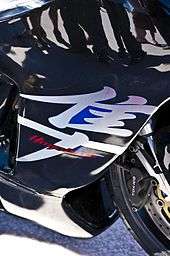
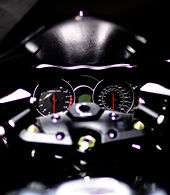
Reflecting in 2009 on the initial design, the creator of the Hayabusa's look, Suzuki's Koji Yoshirua, said that the intent in 1999 was, "to create a somewhat grotesque design and create a strong initial impact... The mission was to create a total new styling that will not be out of date within few years, and a styling that will be the 'Face' of Suzuki." Yoshirua also said that the goal was not to achieve the status of fastest production motorcycle, which in early stages was slated to be only 900 to 1,100 cc (55 to 67 cu in), but that, "as a consequence of, pursuing the best handling, acceleration, safety, power, riding ability, original styling, etc., for the good of the customers, it became the 'Fastest production motorcycle' … By doing this, once the model was out in the market and the performance of it have been proven, I thought that people will start to show interest to the weird design, and then the design would be caked in peoples mind."[35]
The engine used a gear-driven counterbalancer to reduce vibration to the point that the engine could be solidly mounted to the frame, for the purpose of increasing chassis rigidity. Employing a conventional twin beam frame, fully adjustable upside down forks, using specially developed Bridgestone tires, and being relatively light at 473 pounds (215 kg) dry, the Hayabusa's handling was considered excellent for a machine of this class.[5] One reviewer, Koblenz, noted a hesitation perhaps related to poor low-rpm mapping at low speeds, noticeable as a "pause and slight lurch" when rolling on and back off the throttle.[22]
Top speed limited by agreement
With rumors and then pre-release announcements of much greater power in Kawasaki's Ninja ZX-12R in 2000, clearly attempting to unseat Suzuki and regain lucrative bragging rights, the speed war appeared to be escalating. There were growing fears of carnage and mayhem from motorcycles getting outrageously faster every year, and there was talk of regulating hyper sport motorcycles, or banning their import to Europe.[29][8][10][15]
The response was a so-called gentlemen's agreement between the Japanese and European manufacturers to electronically limit the speed of their motorcycles to 300 km/h (186 mph).[5][36] The informal agreement went fully into effect for the 2000 model year.[3][4] So for 2000[3][4] models, and those since, the question of which bike was fastest could only be answered by tampering with the speed limiting system, meaning that it was no longer a contest between stock, production motorcycles, absolving the manufacturer of blame and letting those not quite as fast avoid losing face.[14] Both Kawasaki and Suzuki would claim, at least technically, to have the world's fastest production motorcycle.
Other developments
After the inclusion of the speed limiting system in 2000,[3][4] the Hayabusa remained substantially the same through the 2007 model year. An exception was a response to the problem of the aluminum rear subframe on 1999 and 2000 models breaking when the bike may have been overloaded with a passenger and luggage, and/or stressed by an aftermarket exhaust modification, so 2001 and later Hayabusas had a steel instead of aluminum rear subframe, adding 10 lb (4.5 kg) to the 1999 and 2000 models' approximately 550 pounds (249 kg) wet weight.[37]
Performance and measurements
| Power | Torque | Weight | Tested by |
|---|---|---|---|
| 155.9 hp (116 kW) @ 9,700 rpm | 129.5 N⋅m (95.5 lb⋅ft) @ 8,000 rpm | 1999–2000: 249.48 kg (550 lb) 2001–2007: 254.01–255.3 kg (560–563 lb) (wet) | Motorcyclist[37][38] |
| 151.1 hp (112.7 kW) @ 9,500 rpm | 126.6 N⋅m (93.4 lb⋅ft) @ 7,000 rpm | 250 kg (550 lb) (wet) | Motorcycle Consumer News '99[22] |
| 156.6 hp (116.8 kW) @ 9,500 rpm | 135.0 N⋅m (99.6 lb⋅ft) @ 6,750 rpm | 234 kg (515 lb) (dry) 250 kg (550 lb) (wet) | Sport Rider '99[25] |
| 158.6 hp (118.3 kW) @ 9,750 rpm | 132.1 N⋅m (97.4 lb⋅ft) @ 7,000 rpm | 238 kg (525 lb) (dry) 250 kg (560 lb) (wet) | Sport Rider '01[25] |
| 162.6 hp (121.3 kW) @ 9,750 rpm | 133.4 N⋅m (98.4 lb⋅ft) @ 7,000 rpm | 242 kg (533 lb) (dry) 255 kg (563 lb) (wet) | Sport Rider '05[25] |
| ¼ mile (402 m) | 0 to 60 mph (0 to 97 km/h) | 0 to 100 mph (0 to 160 km/h) | Top Speed | Tested by |
|---|---|---|---|---|
| 10.4 seconds | 310 km/h (190 mph) | Motorcycle News[39] | ||
| 9.86 seconds @ 235 km/h (146 mph) | 194 mph (312 km/h) | Cycle World[6] | ||
| 9.97 seconds @ 233.0 km/h (144.8 mph) | 305.1 km/h (189.6 mph) | Sport Rider 8/99, 12/99[40] | ||
| 9.84 seconds @ 229.75 km/h (142.76 mph) | 2.76 seconds | 5.30 seconds | 303 km/h (188 mph) | Motorcycle Consumer News 6/99[22] |
| 186 mph (299 km/h) | Cycle World[6] | |||
| 10.277 seconds @ 221.9 km/h (137.9 mph) | Motorcyclist[41] | |||
| 9.89 seconds @ 231.02 km/h (143.55 mph) | 2.47 seconds | 296 km/h (184 mph) | Cycle World 06/02 | |
| 10.237 seconds @ 226.18 km/h (140.54 mph) | 296.0 km/h (183.9 mph) | Sport Rider 10/02[40] | ||
| 10.02 seconds @ 230.9 km/h (143.5 mph) | Sport Rider 10/05[40] |
Second generation (2007– )
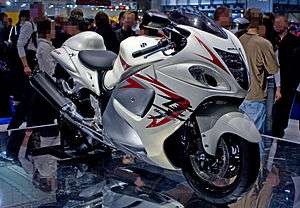 | |
| Also called | GSX-1300R-K8 (2008), -K9 (2009) |
|---|---|
| Engine | 1,340 cc (82 cu in), 4-stroke inline-four, liquid-cooled, DOHC, 16-valve, Keihin/Denso fuel Injection, wet sump |
| Bore / stroke | 81.0 mm × 65.0 mm (3.19 in × 2.56 in) |
| Compression ratio | 12.5:1 |
| Top speed | 299 km/h (186 mph)[41] |
| Power | 197 hp (147 kW)[42](claimed) 172.2 hp (128.4 kW) (rear wheel)@ 10100 rpm[38][41] |
| Torque | 138.7 N⋅m (102.3 lb⋅ft),[42](claimed) 132.6 N⋅m (97.8 lb⋅ft) @ 7600 rpm[38][41](rear wheel) |
| Transmission | 6-speed slipper clutch, constant mesh, #530 chain drive |
| Suspension | Front Inverted telescopic, coil spring, fully adjustable spring preload, adjustable rebound damping and adjustable compression damping Rear Link-type, gas/oil damped, fully adjustable spring preload, adjustable compression & rebound damping |
| Brakes | Front 4-pot Tokico radial mount calipers on 310 mm x 5.5 mm disc Rear Single hydraulic disc |
| Tires | Bridgestone Battlax BT015 Front 120/70-ZR-17, Rear 190/50-ZR-17 |
| Wheelbase | 1,485 mm (58.5 in) |
| Dimensions | L: 2,195 mm (86.4 in) W: 740 mm (29.1 in) H: 1,170 mm (46.1 in) |
| Seat height | 805 mm (31.7 in) |
| Weight | See performance and measurements 250 kg (550 lb) (dry) 264.0–268.5 kg (582–592 lb) (wet) |
| Fuel capacity | 21 L (4.6 imp gal; 5.5 US gal) (California 20 L (5.3 US gal)) |
| Fuel consumption | 7.1 L/100 km; 40 mpg‑imp (33 mpg‑US)[25] |
Suzuki lightly revised the GSX1300R for the 2008 model year, with a minor restyling of the bodywork, and fine-tuning of the engine's head, pistons and exhaust. Though the engine changes were relatively limited, they still yielded a large horsepower increase, and brought the bike into compliance with new noise and emissions requirements.[26][43]
Planning
In 2004, market researchers from the US and Japan began working to identify which elements of the Hayabusa design had attracted so many buyers, discovering that, in spite of having its looks sometimes disparaged in print, customers were much enamored with the old Hayabusa. A redesign meant to strengthen the bike's appearance without departing much from the original found approval with dealers and focus groups. Underneath the skin, Suzuki decided to save considerable development cost by keeping major portions of the frame and engine unchanged.[23] This was because engineers had determined greater power was possible without a significant redesign of the old engine, even faced with the need to comply with more stringent noise and air pollution rules.[44] The target was to produce more than 190 bhp (142 kW) at the crankshaft,[26] and they delivered 194 hp (145 kW), an 11 or 12 percent increase over the previous output.[42][43][45] When the new Hayabusa was released, independent tests bore this out, with 172.2 bhp (128.4 kW) @ 10,100 rpm measured at the rear wheel.[38]
Suzuki's Koji Yoshiura designed the look of the new Hayabusa. He had previously styled the first generation Hayabusa, as well as the Suzuki Bandit 400, RF600R, TL1000S and the SV650. For research, Yoshiura traveled around the United States to bike nights and clubs for a first hand look at the styling aesthetic of the Hayabusa custom scene, and was inspired as much by the look and build of the Hayabusa rider as their custom bikes. While the second generation is very close to the first in overall shape, and is largely dictated by wind tunnel tests, the raised lines and curves are meant to suggest a muscular build. Said Yoshiura, "I wanted to create a masculine form that complements a rider's muscular structure with hints of developed bicep, forearm and calves."[46]
Technical revisions
Engine changes consisted of an increase in stroke by 2 mm, enlarging displacement to 1,340 cc (82 cu in). The compression ratio was boosted from 11:1 to 12.5:1 and the cylinder head was made more compact and was given lighter titanium valves, saving 14.1 g (0.50 oz) and 11.7 g (0.41 oz) on each intake and exhaust valve, respectively. The valves were driven by a chain with a new hydraulic tensioner. The pistons were made lighter by 1.4 g (0.049 oz)[44] and used ion-coated rings and shot peened connecting rods.[26] The crankcase breather system had reed valves added to control pressure waves in the intake airbox, a way of avoiding power loss.[44]
Fuel injectors from the GSX-R1000 were used, with smaller 44-millimetre (2 in) throttle bodies, called the Suzuki Dual Throttle Valve (SDTV) system. It has three selectable options of power delivery for a range of touring to wide open high performance.[43] The exhaust system was overhauled, using a 4-2-1-2 system, meaning four exhaust outlets merging into two pipes, and then joining into a single pipe before splitting into two enlarged, quieter mufflers, which added a few pounds of weight compared to the first generation Hayabusa. The exhaust also included a catalytic converter and an oxygen sensor in order to meet Euro 3 emissions requirements.[26]
The suspension was upgraded with a 43 mm Kayaba inverted fork with sliders having a diamond-like carbon (DLC) coating. The rear shock is also a Kayaba, and the overall suspension is firmer than the previous model. The swingarm is similar in design to the old one, but was strengthened. Front and rear remain fully adjustable. The transmission was given a heavier-duty, slipper clutch. The final drive ratio was slightly lower, and gears 5-6 were spaced farther apart, and gear ratios 1-2 moved closer together.[26]
Ergonomic and cosmetic changes for the 2008 model include a higher windscreen, and interlocking gauge faces with a digital speedometer, as well as a new gear indicator and adjustable shift light. The fairing fasteners were hidden to uncomplicate custom paint work. The twin-spar aluminum frame was carried over from the previous version, and wheelbase, rake/trail, and seat height were the same, while overall length grew by two inches, and the taller windscreen added about ½ inch.[23] Weight was saved by omitting the centerstand.[26]
Technical improvements in the chassis include Tokico radial brake calipers, allowing smaller discs and therefore lower unsprung weight, translating into superior handling. Increased front braking power[42] necessitated a sturdier lower triple clamp. The rear brake caliper was moved to the top of the disc, giving a cleaner visual appearance. New 17 inch wheels were designed, using Bridgestone BT-015 radials taken almost directly from the GSX-R1000.[26]
Other changes were a steering damper with a reservoir and dual cooling fans with a larger, curved radiator. Because of increased vibration from the longer stroke, the fuel tank was put on floating mounts. All told, the changes for 2008 resulted in a dry weight of 490 lb (222 kg), 5 lb (2 kg) heavier than the prior generation.[26]
Other developments
Suzuki has dropped the GSX1300R designation in some countries and simply called the motorcycle the Hayabusa.
In October 2009, the company celebrated the tenth anniversary of the Hayabusa in Santa Pod raceway where more than 500 owners of Hayabusas converged. Many events were organized and prizes were distributed to people who visited the event.[47]
There were no changes through the 2011 model year except new colors.[48]
Alongside the second generation Hayabusa, Suzuki developed the new B-King, a naked bike in the streetfighter mold, using the same engine but with a different intake and exhaust.[26][49]
Performance and measurements
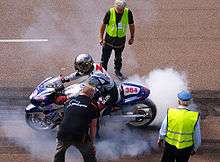
| Horsepower | Torque | Weight | Tested by |
|---|---|---|---|
| 172.2 hp (128.4 kW) @ 9,500 rpm | 97.6 lb⋅ft (132.3 N⋅m) @ 8,500 rpm | 268.5 kg (592 lb) (wet) | Motorcyclist[38][41] |
| 164.8 hp (122.9 kW) @ 10,100 rpm | 97.8 lb⋅ft (132.6 N⋅m) @ 7,600 rpm | 250 kg (550 lb) (dry) 264 kg (583 lb) (wet) | Sport Rider[25] |
| ¼ mile (402 m) | 0 to 60 mph (0 to 97 km/h) | 0 to 100 mph (0 to 160 km/h) | Top Speed | Tested by |
|---|---|---|---|---|
| 10.2 seconds | 186 mph (299 km/h) | Motorcycle News[42] | ||
| 9.7 seconds @ 148.8 mph (239.5 km/h) | 186 mph (299 km/h) | Cycle World Feb. '08[50] | ||
| 10.14 seconds @ 142.54 mph (229.40 km/h) | 186 mph (299 km/h) | Motorcyclist Dec. '07[41] | ||
| 9.75 seconds @ 147.2 mph (236.9 km/h) | 2.6 seconds | 186 mph (299 km/h) | Cycle World Mar. '08[51] |
Sales
Typically, a new sportbike model sells well in its first year, and then sees its numbers decline every year as it grows older. The Hayabusa reversed this pattern, selling in greater numbers every year from the 1999 launch through the 2008 revision.[26][52] From its debut in 1999 to June 2007 over 100,000 Hayabusas were sold worldwide.[23] In the United States in each of the years 2005 and 2006, over 10,000 units were sold.[53][54]
It was predicted that the gentlemen's agreement speed cap would hurt sales, because buyers would not want a bike that was hobbled with a speed limiter, even riders who would never approach the hypothetical maximum.[11] However, sales in the United States have increased year after year since its release in 1999 until 2006 and went from just a few thousand units in 1999 to over 10,000 in 2006.[53]
The Hayabusa blew away that standard, because at first many didn’t understand it. The superbike guys didn’t want something so heavy, the cruiser guys thought it too sporty, but once its power was proven and its fame increased, it was latched onto by the drag race scene as an indestructable demon down the dragstrip with more power than anything in its time.
Then it became popular with the custom crowd who just wanted a beef of a motor, with a unique look that they could chrome, stretch, and expand on. It offered an alternative to the cruiser scene that the manufacturers didn’t even know existed. Those who wanted to cruise, but didn’t want a cruiser. Something that was insanely fast from stop light to stop light, but was also a great all-arounder for in town use and easy to ride if kept in the lower rpm’s. It offered both with a lot of wow factor that they could brag about at there local haunt.
Competitive motorsports
Many riders have found that the Hayabusa lends itself well to any number of legitimate functional purposes, to include competitive motorsports.
The Hayabusa has been used in sanctioned closed course road racing,[55][56] drag racing,[57] and top speed competition.[58]
Top speeds of over 270[58] mph, engine outputs of over 700[59] horsepower, and performances in the standing quarter mile as quick as 6.9 seconds and as fast as 209.14[60] mph have been recorded by street registered Hayabusa motorcycles using standard-width (190mm) DOT-approved street-legal rear tires.
On July 17, 2011, riding a highly modified turbocharged Suzuki Hayabusa, Bill Warner set a new world motorcycle land speed record of 311.945 miles per hour (502.027 km/h) from a standing start to 1.5 miles at the Loring Timing Association's Land Speed Race, held at the Loring Commerce Centre (the former Loring Air Force Base) in Limestone, Maine.[61][62][63]
Custom versions
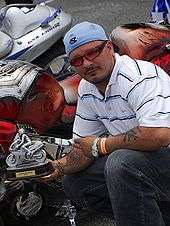
The Hayabusa has been one of the top choices for streetbike customization,[64] perhaps even the most popular customized sportbike.[52][65][66] One reason may be the unique, instantly recognizable bodywork.[52] The easy tunability of the engine, the wide selection of aftermarket parts, possibly more than any other Japanese motorcycle, and the interchangeability between models of Suzuki parts have also played a role.[65] It was the vibrancy of this custom scene that prompted Suzuki to send Koji Yoshirua to the US for feedback and inspiration for the second generation design.[46]
Bikes are typically built to impress with being the most extreme, and most innovative. For professional custom shops, the status as the first builder to introduce a new style or customization — a 300 mm-series rear tire width, for example — is often hotly contested, and can pay dividends in media attention and in sales.[65] Celebrity customers, such as rappers or NBA stars, also serve to build the credibility of a custom shop.[65] The bikes themselves, at shows, racetracks, dragstrips and at build competitions, also serve as "rolling billboards" for their makers.[67][68]
Bikes are usually built around a theme,[65] such as a NASCAR-inspired bike with retro-70s chrome wheels, racing numbers, flames and sponsor insignia reminiscent of a stock car, or a bike that takes its cues from popular films, such as Freddy Krueger of A Nightmare on Elm Street. Other common motifs in custom artwork are sexy women, skulls, bones and other gruesome figures, and money and bling, such as "Ben Franklins," $100 bills.[65] ![]()
Power enhancement
Horsepower enhancements like nitrous injection, which can add 100 bhp (75 kW), and turbocharging, which can raise power to more than 600 bhp (450 kW)[69], are common.
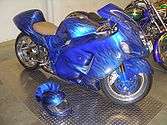
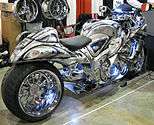
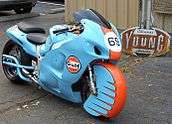
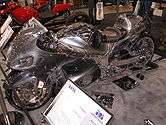
Police use
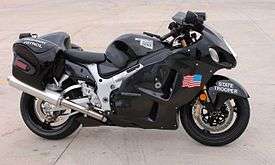
In 2006 the Oklahoma Highway Patrol (OHP) converted a seized Hayabusa into a pursuit vehicle, setting up the bike with equipment including a radar unit, police lights and siren, and painting it in official colors and insignia. Impressed with the positive response from the public and the motorcycling community, the OHP purchased two more Hayabusas, to supplement their main fleet of Harley-Davidson police motorcycles. While they are used for patrol, the primary function of the Hayabusas is public relations and community outreach, due to the kind of attention the exotic bikes attract. According to the OHP, "There are clear lines dividing sportbike and cruiser motorcycle riders. We feel the sportbike community has not been given the proper amount of attention and focus in the area of community involvement and rider safety education."[70]
In 2009, Humberside Police in the United Kingdom put an undercover Hayabusa on the road, equipped with speed detection equipment and a video camera, as part of Operation Achilles, which aimed to catch speeding motorists and motorcyclists.[71][72]
Other uses of the Hayabusa engine
The high-powered lightweight engine in the Hayabusa lends itself to non-motorcycle applications. The Westfield Megabusa is an English sports car, based on the Lotus Seven, which uses the Hayabusa engine.[73] Suzuki was the first to put the motorcycle's engine in a car, with two concept cars in 2001, the Suzuki GSX-R/4 roadster and the Formula Hayabusa, an open wheel race car "designed for a new Japanese one-make competition series."[74][75]
Mike Akatiff's 2004 land speed record attempt TOP 1 Ack Attack streamliner used twin Hayabusa engines in an attempt to exceed 483 km/h (300 mph) at Bonneville Salt Flats.[76] In 2006 and again in 2008 Akatiff's Ack Attack, ridden by Rocky Robinson, succeeded, first going 552 km/h (342.797 mph) in 2006, only to be surpassed two days later, then returning in 2008 to set another new record of 581 km/h (360.913 mph).[77][78] That record stood until 24 September 2009, when it was broken by Chris Carr with a speed of 591 km/h (367.382 mph).[79]
Radical Sportscars use the Hayabusa engine in stock form in their SR1 entry level race car and in a modified form up to 1.6L in their SR3 and PR6 cars.[80] They also designed a 2.8 L (170 cu in) V8 engine based on the inline-four Hayabusa engine using dual Hayabusa cylinder heads mated to a custom bottom end, known as the Powertec RPA V8 engine to power their SR8 car. The 455 bhp (339 kW) sports car set the record for the fastest production car at Nürburgring.[81]
John Hartley, president of a custom printing machine manufacturer, created a 75° V8 engine producing 400 bhp (300 kW) and 332–339 N⋅m (245–250 lb⋅ft) torque that weighs 200 lb (91 kg), based on the Hayabusa engine, initially intended to power his Caterham Seven sports car.[82][83] One of Hartley's engines has also been put in an Ariel Atom open wheel roadster.[84][85]
SmartBUSA sells a conversion kit to install Hayabusa engines in Smart Cars.[86]
The Vitabusa is a race car original designed by West Racing Cars, appeared in PIC, Taiwan.[87]

A project to build a modern replica of the 1939 Bugatti Model 100 air racer used twin Suzuki Hayabusa engines in place of the original design's pair of supercharged straight-eight engine.[88]
Hayabusa engines have been used in sandrails, lightweight space frame off-road vehicles for sand dune racing and recreation. While many sandrails used in events like the Abu Dhabi Desert Challenge have relied on car V8 engines, lighter motorcycle engine like the Hayabusa 1300 gives the sand car advantages in acceleration and maneuverability.[89]
The GWR Raptor is a hill-climb racing car by Graeme Wight Jr.; it normally uses a Hayabusa engine (and transmission).
See also
Notes
- Some journalists have made plays on the name Hayabusa, such as "Hay Bus" (Boehm 2007) and "the High Abuser" (Mahler 1999), but these are not in wide currency.
- http://www.autocarindia.com/auto-features/suzuki-hayabusa-make-in-india-402738.aspx
- Trevitt, Andrew (June 2010), "Big Dogs: Derestriction; Uncorking the top-speed potential of the Hayabusa and ZX-12R", Sport Rider, archived from the original on May 11, 2012
- "2000 Suzuki GRS1300R Hayabusa Program #1922", MotorWeek, archived from the original on March 13, 2004
- Brown (2005) pp. 242–243, 276–277
- Hoyer (2007)
- Burns, John (April 2, 2012), "Fifty Years of "Do You Have Any Idea How Fast You Were Going?" A brief history of Ludicrous Speed", Cycle World, archived from the original on April 7, 2012, retrieved September 17, 2017CS1 maint: unfit url (link)
- Brown (1999)
- Richardson (1999)
- Cole (1999)
- Boule (2000)
- Ford (2003)
- Searle (2009)
- End of the arms race? (2000) p. 31
- Mahler (1999)
- Levine (1998)
- Ash (1999)
- The Hayabusa could just as easily be called the "fastest production motorcycle of the millennium." Guinness World Records, in 2000 and in 2001, lists the Hayabusa as "the fastest production bike in the world," with a top speed of 312 km/h (194 mph). See Kynaston (2000) p. 179, Footman (2000) p. 139
- Brown (2005) pp. 284-285
- Hartfiel (1999). "Among the accolades, the Hayabusa was named Cycle World's 'Superbike Of The Year' and Motorcyclist's 'Motorcycle Of The Year.' It also won Popular Mechanics' 2000 Design & Engineering Award and was named the 'World's Fastest Production Bike' in the millennium issue of the Guinness Book Of World Records. Consumer's Digest picked the SV650 as the 'Best Buy' in motorcycles, 'and several of the buff books singled out the SV650 for special recognition... Even our dealership information center won an award,' noted Harris. The Point-Of-Purchase Advertising Institute awarded Suzuki's Literature Information Center/Video Monitor Display a bronze medal."
- Ker (2007) p. 230
- Koblenz (1999)
- Edwards (2007)
- See http://www.suzukipartshouse.net/oemparts/a/suz/50d40e98f8700230d8b50861/electrical, the central unit (the restriction is put inside the ECM, it's an electronic limit) is the same for both models (check the part 32920-24F21)
- Sport Rider (2008) Weights and Measurements. 1999: 8/99, 12/99, '01: 10/02, '05: 10/05, '08: 4/08
- Boehm (2007)
- Mancini & Higdon (2004)
- Sarlau, Vlad (January 5, 2017). "Suzuki Hayabusa - Japan's Mechanical Falcon". DriveMag Riders. Archived from the original on July 29, 2019. Retrieved July 29, 2019.
- Carrithers (2006)
- Hoyer (2007) "When Suzuki first launched the bike, it explained that hayabusa was the Japanese word for a very fast falcon that, not coincidentally, fed on blackbirds."
- Honda's Blackbird series of motorcycles do not take their name directly from falcon fodder, but rather from the SR-71 Blackbird aircraft. See Faux (1996) and "Hey, Nice Covert Warrior" (2006).
- Or by 23 km/h (14 mph). See Koblenz (1999)
- Webber (1999)
- Carrithers (2006). "[For] those who aren't appalled by its bulbous silhouette... Styling reminiscent of a walleye pike."
- Westlake (2009)
- Sources vary as to whether this unofficial agreement is precise or only approximate, and whether it is defined as 300 km/h or as 186 mph, though the European and Japanese manufactures normally use metric units.
- Smart Money (2003)
- 2007 And 2008 Suzuki GSX1300R Hayabusa - Hard Parts. Note: p. 1 is 1st gen. 2007, p. 2 is 2nd gen. 2008.
- "Suzuki GSX1300R Hayabusa (1999-2007)". Retrieved 2009-10-17.
- GSX1300R Performance Numbers (2005)
- Frank (2007)
- Suzuki GSX1300R Hayabusa (2007-current)
- Edge (2007). "An all-new 2008 Hayabusa featuring a 1,340 cc (82 cu in) engine with a claimed eleven percent increase in performance headlines this late June announcement"
- Kelly (2007)
- Hilderbrand (2007)
- Canet (2007)
- "Archived copy". Archived from the original on 2010-03-08. Retrieved 2010-01-14.CS1 maint: archived copy as title (link)
- Newbigging (2009)
- Potter (2007)
- Canet & February 2008
- Canet & March 2008
- Fivella (2009)
- Hutchinson (2006)
- "Suzuki Hayabusa - All Hail Hayabusa!". motorcyclistonline.com.
- "Archived copy". Archived from the original on 2010-08-02. Retrieved 2010-04-30.CS1 maint: archived copy as title (link)
- Assoc, American Motorcyclist (1 August 1999). "American Motorcyclist". American Motorcyclist Assoc – via Google Books.
- http://www.amadragbike.com/news/templates/classes_tmp.asp?articleid=55&zoneid=13%5B%5D
- "Hayabusa Streetbike Sets Top-Speed Record At 272.340 mph On Maxton Mile". www.roadracingworld.com.
- "Horsepower Record Meltdown at 701.32 !". superstreetbike.com.
- "Tony Ficher : 200mph 6 second Pro Charged Suzuki Hayabusa". Dragbike.com. December 19, 2015. Retrieved April 5, 2016.
- Slotnik, Daniel E. (July 17, 2013). "Bill Warner, Who Set Speed Record on Motorcycle, Dies at 44". The New York Times. Retrieved July 22, 2013.
- Bowman, Zach (July 20, 2011). "Watch Bill Warner's record-setting 311-mph motorcycle run". AOL. Retrieved July 22, 2013.
- Ford, Dexter (July 22, 2011). "Riding Alfresco, Motorcyclist Sets Record With 311.94 M.P.H. Run". The New York Times. Retrieved July 22, 2013.
- "Best Used Bikes: Suzuki Hayabusa", Cycle World, vol. 50 no. 1, p. 77, January 2011, ISSN 0011-4286
- Seate (2006)
- Booth (2008)
- Seate (2005)
- Dolgner (2009)
- "Hayabusa Streetbike Sets Top-Speed Record At 272.340 mph On Maxton Mile", Roadracing world and motorcycle technology, April 13, 2010, retrieved April 13, 2010
- Oklahoma Highway Patrol Uses Hayabusa (2008)
- "Bikers' protest ride at police tactics >vid". Hull Daily Mail. 24 March 2010. Archived from the original on 1 July 2015. Retrieved 6 January 2010.
- "12 months in prison for 139mph speeding biker". Motor Cycle News. 20 July 2009. Retrieved 20 July 2009.
- SE Megabusa (2008)
- American Suzuki Motor Corporation (2002)
- American Suzuki Motor Corporation (2009)
- Parsons (2004)
- Parsons (2006)
- Motorcycle.com Staff (2008)
- Harley (2009)
- "SR3". Radical Sportscars.
- Crowe (2007)
- Sawyer (2007)
- Hartley Enterprises
- Downes, Andy. "BMW S1000RR second fastest EVER on Top Gear test track - | Motorcycle News | Bike News | Motorbike Videos | MCN". Motorcycle News. Retrieved 2011-12-30.
- Paul Crowe - "The Kneeslider". "Hayabusa V8 Powered Ariel Atom by Dennis Palatov". Thekneeslider.com. Retrieved 2011-12-30.
- "Home of SmartBUSA - Hayabusa GSXR 1300 powered Smart Car". Smartbusa.us. Archived from the original on 2010-02-27. Retrieved 2011-12-30.
- "馳風‧逐夢‧尋未來─Vitabusa 1.3龍潭賽車場試駕 -U-CAR試車報告". U-car.com.tw. 2011-08-23. Retrieved 2012-09-07.
- Lerner, Preston (September 2014), "Aviation's Sexiest Racer", Air & Space Magazine, retrieved October 27, 2016
- Rossetti, Paolo (January 22, 2011), "On the dunes, the Barracuda Buggy is hard to beat", The National (Abu Dhabi), retrieved October 27, 2016
References
- American Suzuki Motor Corporation (January 4, 2002), Suzuki Shows Part Car, Part Motorcycle Concept And Race Vehicles At Los Angeles Auto Show (press release), archived from the original on January 7, 2011, retrieved 2009-11-10
- American Suzuki Motor Corporation (2009), Suzuki Auto / Concept Cars, archived from the original on 2009-11-05, retrieved 2009-11-10
- Ash, Kevin (2 October 1999), "Motoring: Kawasaki comes out of the closet", The Daily Telegraph, London, UK, p. 12, OCLC 49632006
- Boehm, Mitch (August 2007), "2008 Suzuki Hayabusa", Motorcyclist, Source Interlink Media, pp. 46–61, ISSN 0027-2205
- Booth, David (September 19, 2008), "Suzuki purrs like a pussycat, but it's wild; Hayabusa is outrageously powerful", Ottawa Citizen, Ottawa, Ontario: James Orban, p. D.13, ISSN 0839-3222
- Boule, Joe (21 July 2000), "Putting the brakes on big bikes: Kawasaki backs off 300 km/h barrier amid rumours of a speed cap; [Final Edition]", Ottawa Citizen, Ottawa, Ontario: James Orban, p. C.1.FRO, ISSN 0839-3222
- Brown, Roland (2 October 1999), "200mph superbike has its makers scared; [1F Edition]", The Times, London, UK: News Corporation, p. 53, ISSN 0140-0460
- Brown, Roland (2005), The ultimate history of fast motorcycles, Bath, UK: Parragon, ISBN 1-4054-5466-0
- Canet, Don (December 2007), "Suzuki Hayabusa.(NEW BIKES 2008)(Suzuki GSX1300R Hayabusa)(Product/service evaluation)", Cycle World, Newport Beach, California: Hachette Filipacchi Media U.S., vol. 46 no. 12, pp. 56–60, ISSN 0011-4286
- Canet, Don (February 2008), "Hayabusa by the numbers", Cycle World, Newport Beach, California: Hachette Filipacchi Media U.S., vol. 47 no. 2, p. 33, ISSN 0011-4286
- Canet, Don (March 2008), "Dancing with the stars.(Kawasaki ZX-14 vs. Suzuki Hayabusa)(Product/service evaluation)", Cycle World, Newport Beach, California: Hachette Filipacchi Media U.S., vol. 47 no. 3, pp. 36–42, ISSN 0011-4286
- Carrithers, Tim (January 2006), "Smart Money; 1999-2006 Suzuki GSX1300R Hayabusa", Motorcyclist, Source Interlink Media, p. 82, ISSN 0027-2205
- Crowe, Paul (7 May 2007), "Hayabusa V8 Grows Up – 2.8 liter 455bhp", The Kneeslider, retrieved 2009-11-24
- Cole, Bernard (14 March 1999), "High-speed fears over superbikes. [Early Edition]", Sunday Mercury, Birmingham, UK: Trinity Mirror, p. 6, ISSN 0039-5242
- Dolgner, Beth (2009), "Who's Who in the Sportbike Industry", Dealernews, Irvine, California: Advanstar Communications, 45 (4): 64, ISSN 0893-2522
- Edwards, David (June 2007), "First Look: 2008 Suzuki Hayabusa", Cycle World, Newport Beach, California: Hachette Filipacchi Media U.S., ISSN 0011-4286, archived from the original on 2008-03-20
- Edge, Dirck (2007-06-27), "Suzuki Introduces 1300 cc Hayabusa, B-King, and Fuel-Injected RM-Z450 Motocrosser", Motorcycle Daily, archived from the original on 2007-07-01, retrieved 2007-12-17
- "End of the arms race?; Why the '99 Hayabusa might be the last king of speed", Motorcyclist, Source Interlink Media, p. 31, June 2000, ISSN 0027-2205
- Faux, Roland (2 November 1996), "Blackbird: common or garden it certainly ain't; [1 Edition]", The Times, London, UK, p. 1, ISSN 0140-0460
- Fivella, Justin (June 2009), "1999-2009 Suzuki GSX1300R Hayabusa - A Decade Of Dominance; Super Streetbike Pays Tribute To The King Of Speed On Its Tenth Anniversary", Super Streetbike, Source Internlink Media, ISSN 1934-4996
- Footman, Tom (2000), Guinness world records 2001, London: Guinness World Records, ISBN 1-892051-01-X
- Ford, Dexter (August 2003), "Grudge Match", Motorcyclist, Source Interlink Media, pp. 34–35, ISSN 0027-2205
- Frank, Aaron (December 2007), "Big Bird Smackdown", Motorcyclist, Source Interlink Media, pp. 62–81, ISSN 0027-2205
- Harley, Bryan (25 September 2009), "BUB Racing's Chris Carr Breaks Speed Record", Motorcycle USA, Medford, Oregon
- Hartfiel, Robin (November 1999), "The Journey Continues: Suzuki Dealers Steal The Show", Dealernews, Irvine, California: Advanstar Communications, 35 (12): 32+, ISSN 0893-2522
- Hartley Enterprises, History 1 Page, retrieved 2009-11-24
- "Hey, Nice Covert Warrior!", American Motorcyclist, Westerville, Ohio: American Motorcyclist Association, vol. 60 no. 9, September 2006, ISSN 0277-9358
- Hilderbrand, JC (29 June 2007), "2008 Suzuki Hayabusa and B-King", MotorcycleUSA.com, retrieved 2007-07-29
- Hoyer, Mark (June 2007), "'Busas, Baby! Looking Back at Suzuki's Steamroller of Speed", Cycle World, Newport Beach, California: Hachette Filipacchi Media U.S., ISSN 0011-4286
- Hutchinson, Ken (15 July 2006), "2006 ZX-14 vs. Hayabusa", MotorccleUSA.com, retrieved 2009-11-02
- Ker, Rod (2007), Classic Japanese Motorcycle Guide, Sparkford, UK: Haynes Publishing, p. 230, ISBN 1-84425-335-X
- Kelly, Keven M. (October 2007), "Suzuki refines Hayabusa engine", Automotive Design & Production, Cincinnati, Ohio: Gardner Publications, 119 (10): 30, ISSN 1536-8823
- Kynaston, Nic (2000), Guinness world records 2000; Millennium Edition, London: Guinness World Records, ISBN 1-892051-00-1
- Koblenz, Jay (June 1999), "99 Suzuki GSX1300R Hayabusa; Bullet Train On Wheels (model evaluation)", Motorcycle Consumer News, Irvine, California: Aviation News Corp, pp. 30–33, ISSN 1073-9408
- Levine, Ray (4 October 1998), "Ugly Suzi's so fast; [Final 1 Edition]", News of the World, London, UK: News Group Newspapers, p. 64, OCLC 50874256
- Mahler, John (15 May 1999), "The speed zone ; Suzuki's High Abuser puts temptation a wrist-twist away; [1 Edition]", Toronto Star, Toronto, Ontario: B.H. Honderich, p. 1, ISSN 0705-7857
- Mancini, Julie Rach; Higdon, Pam (2004), Guide to Backyard Birds, Barron's Educational Series, p. 73, ISBN 0-7641-2687-3, retrieved 2009-11-02
- Motorcycle.com Staff (29 September 2008), "New motorcycle land speed record set; Top 1 Ack Attack team reaches 360 mph", Motorcycle.Com, retrieved 2009-10-13
- Newman, Mark (2006), "Mopeds And Motorcycles Map No. 32", Worldmapper: The world as you've never seen it before, SASI Group (University of Sheffield) and Mark Newman (University of Michigan), archived from the original on 2018-03-20, retrieved 2009-11-02 See also Technical Data
- Newbigging, Chris (8 October 2009), 2010 Suzuki Hayabusa and GSX650F colours
- "Oklahoma Highway Patrol Uses Hayabusa", Dealernews, Irvine, California: Advanstar Communications, 1 July 2008, ISSN 0893-2522, archived from the original on 24 October 2008
- Parsons, Grant (December 2004), "11 Good Reasons Nobody ever said going 322 mph at the Bonneville Salt Flats was easy", American Motorcyclist, Westerville, Ohio: American Motorcyclist Association, vol. 58 no. 12, p. 28, ISSN 0277-9358
- Parsons, Grant (November 2006), "Racing for the Record", American Motorcyclist, Westerville, Ohio: American Motorcyclist Association, vol. 60 no. 11, p. 34, ISSN 0277-9358
- Potter, Marc (2007-07-31), "Suzuki B-King is launched", Motorcycle News, retrieved 2007-10-31
- Richardson, Mark (3 July 1999), "Adrenalin rush should not be a prelude to death ; Young novices and fast bikes don't mix; [1 Edition]", Toronto Star, Toronto, Ontario: B.H. Honderich, p. 1, ISSN 0705-7857
- Searle, Dave (October 2009), "Measures", Motorcycle Consumer News, Irvine, California: Aviation News Corp, vol. 40 no. 10, p. 2, ISSN 1073-9408
- Sawyer, Christopher A. (1 October 2007), "Creating a Half-Pint Heavyweight", Automotive Design & Production, archived from the original on 12 February 2009, retrieved 2009-11-24
- Seate, Mike (2005), "Custom 2005 Suzuki Hayabusa - Money Shot Myrtle Beach's 360 Motorsports shows us the money with this big-bucks, big-tire 2005 Suzuki Hayabusa steamroller.", Super Streetbike, Source Internlink Media, ISSN 1934-4996, retrieved 2009-11-02
- Seate, Mike (2006), "A Slammed and Lowered 'Busa: The Undisputed King of Pro Streetbikes", How to Build a Pro Streetbike, St Paul, Minnesota: MBI Publishing Companyf, pp. 9–40, ISBN 0-7603-2450-6, retrieved 2009-11-02
- "Smart Money; Suzuki Hayabusa, 1999-2003", Motorcyclist, Source Interlink Media, p. 127, May 2004, ISSN 0027-2205
- "SE Megabusa". Westfield Sportscars Ltd. Archived from the original on 2008-12-18. Retrieved 2008-12-02.
- Srivastava, Samar (27 November 2008), "Suzuki targets slump-defying superbike segment", livemint.com
- "Suzuki GSX1300R Hayabusa (2007-current)". Motorcycle News. Retrieved 2008-01-04.
- "Suzuki smiles after selling 100 units of Rs 12.5 lakh bikes", The Economic Times, 10 July 2009
- The Suzuki Hayabusa GSX1300R Arrives in Thailand, July 23, 2009
- Webber, Matt (June 1999), "99 Suzuki GSX1300R Hayabusa; Bullet Train On Wheels (Testers' Log)", Motorcycle Consumer News, Irvine, California: Aviation News Corp, p. 32, ISSN 1073-9408
- "Weights and Measurements", Sport Rider, Los Angeles, California: Source Interlink Media, April 2008, ISSN 1065-7649
- Westlake, John (23 December 2009), "Hayabusa creator says it was meant to be ugly!", Motorcycle News, retrieved 2010-01-27
Further reading
- "2007 And 2008 Suzuki GSX1300R Hayabusa - Hard Parts", Motorcyclist, Source Interlink Media, ISSN 0027-2205, retrieved 2009-11-02
- Cook, Marc (June 2000), "Conspiracy theory; Are Kawasaki and Suzuki secretly trying to slow you down?", Motorcyclist, Source Interlink Media, ISSN 0027-2205
- "GSX1300R Performance Numbers", Sport Rider, Los Angeles, California: Source Interlink Media, October 2005, ISSN 1065-7649, archived from the original on 2008-02-12
- "Hop aboard, feel the horsepower", South China Morning Post, Hong Kong: SCMP Group, p. 44, 3 December 1999, OCLC 5340667
- Ridley, Harriet (2006-09-09), "I'm in the club.", The Daily Telegraph, London, UK: Telegraph Media Group, OCLC 49632006, retrieved 2010-05-24
External links
| Wikimedia Commons has media related to Suzuki Hayabusa. |
| Records | ||
|---|---|---|
| Preceded by Honda CBR1100XX |
Fastest production motorcycle 1999 |
Succeeded by Kawasaki ZX-12R |
